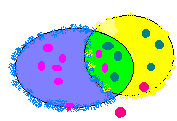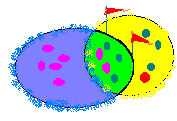Every situation, every person is different. For culture to endure, it must be flexible enough to accommodate many different circumstances. One useful metaphor for culture is the toolbox--one that comes with a stack of reference manuals. Instead of saying "in this culture we make tables THAT way, we raise children or cook a meal THIS way", we acknowledge that culture gives us a set of tools for the task, along with a guide book that suggests how we might use those tools and what the results should look like. Cultural "tools" for making dinner would include heat source and cooking vessels, knowledge of food stuffs, recipes, knives, rules for what items are served at which time of day to which kinds of guests.
Culture as Set of Options.
More broadly, one can think of culture in mathematical terms as a set (albeit with fuzzy boundaries) that contains accepted options, tools, and reference books. If you have a friend over to dinner, you have a number of culturally appropriate choices--you can order out for pizza, cook them a gourmet meal, take them to a restaurant, have a barbeque.

Other options are possible but less likely in the US these days, such as killing and plucking a chicken in their honor; these exist at the margin of the cultural set--on their way in or out. The red dots represent yet other potential responses which lie "beyond the pale" and would not even be considered, such as roast dog, or sending the guest to the neighbors to beg food because you don't have enough.
This way of conceptualizing culture helps account for the many differences within a culture. Context, personality, and subcultures will affect which options people perceive and carry out, while still maintaining group boundaries about what is normal and acceptable. This metaphor also helps explain why culture endures, because options that prove satisfactory will continue to be selected and reinforced by a variety of people in many contexts over time. "Sets of options" also gives intercultural trainers a way of talking about cultural patterns that avoids the simplistic "THE Chinese do it THIS way" stereotype while still giving foreigners guidance about typical or workable options.
 When cultures interact, they will find that some of their options, tools, references will overlap. Some will remain distinctly of one culture or the other. The yellow culture may incorporate red dots that the blue culture considers taboo. Yet culture change occurs when the blue folks see a green dot over there in yellow land, and think "hmm, we never thought of THAT, let's try it". Or in a nastier situation, perhaps the yellows have enough power to force the blues into adopting new options. In either case, the blues now have a different set of options -- even though they continue to think of themselves as strictly blue.
When cultures interact, they will find that some of their options, tools, references will overlap. Some will remain distinctly of one culture or the other. The yellow culture may incorporate red dots that the blue culture considers taboo. Yet culture change occurs when the blue folks see a green dot over there in yellow land, and think "hmm, we never thought of THAT, let's try it". Or in a nastier situation, perhaps the yellows have enough power to force the blues into adopting new options. In either case, the blues now have a different set of options -- even though they continue to think of themselves as strictly blue.
Boundaries as Culture Containers
We know that change and instability in cultures is a given. Institutions and group membership change over time. The beliefs and practices of your grandmother's ethnic group 75 years ago do not look like the beliefs and practices you follow in your own life. Is a group "ethnic" if its fundamental characteristics change? (This generational question has been an ongoing tension for immigrant groups, and is a hot issue in litigation around Native American tribal rights. Is ethnicity a matter of blood, of particular cultural practices--as defined by whom?, a matter of personal assertion, of nationality, or determined by the formal or informal decisions of your ethnic group about who belongs?)
One way to understand culture is to look past the particular characteristics of cultural practice or bloodlines, and pay attention to a culture's boundaries. This metaphor says the box is more significant than its current content. Cultures are ephemeral results of group experience, not the definition of that group.
Rather it is the boundary between one group and another, the dichotomy, the comparison, that produces cultural patterns. Anthropologist Frederick Barth sees cultural meanings and patterns as forming on each side of a barrier like morning frost. Without walls the meaning does not crystalize. Boundaries are reinforced by stereotyping, and by each group occupying particular niches in the larger culture (a parallel is how siblings will often develop different strengths and roles within a family).

In this situation, even though blue and yellow live close enough to have a large green area of overlap, the historical boundary between them remains strong. Although they will continue to share and adapt and negotiate in the green area, a limited number of differences come to have high emotional and political charge. People may be willing to die for these boundary markers, which come to represent a group's identity. These may be internally chosen (Jerusalem for the Israelis and Palestinians, Cyrillic vs Roman alphabet in the Balkans) or externally imposed (The Nazi use of pink triangles and yellow stars, for example, or dark skin and African features which are boundary markers for US racial groups.).
This boundary marker metaphor can help during conflicts to decide which issues are more readily negotiable; which ones will be difficult even if they seem trivial to an outsider.
